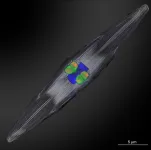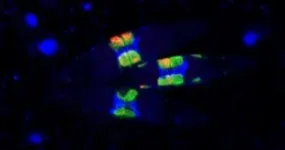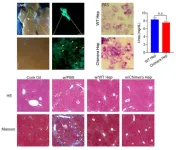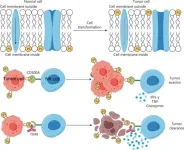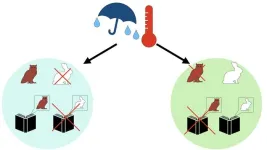(Press-News.org)
Nitrogen is an essential component of all living organisms. It is also the key element controlling the growth of crops on land, as well as the microscopic oceanic plants that produce half the oxygen on our planet. Atmospheric nitrogen gas is by far the largest pool of nitrogen, but plants cannot transform it into a usable form. Instead, crop plants like soybeans, peas and alfalfa (collectively known as legumes) have acquired Rhizobial bacterial partners that “fix” atmospheric nitrogen into ammonium. This partnership makes legumes one of the most important sources of proteins in food production.
Scientists from the Max Planck Institute for Marine Microbiology in Bremen, Germany, now report that Rhizobia can also form similar partnerships with tiny marine plants called diatoms – a discovery that solves a long-standing marine mystery and which has potentially far-reaching agricultural applications.
An enigmatic marine nitrogen fixer hiding within a diatom
For many years it was assumed that most nitrogen fixation in the oceans was carried out by photosynthetic organisms called cyanobacteria. However, in vast regions of the ocean there are not enough cyanobacteria to account for measured nitrogen fixation. Thus, a controversy was sparked, with many scientists hypothesizing that non-cyanobacterial microorganisms must be responsible for the “missing” nitrogen fixation. “For years, we have been finding gene fragments encoding the nitrogen-fixing nitrogenase enzyme, which appeared to belong to one particular non-cyanobacterial nitrogen fixer”, says Marcel Kuypers, lead author on the study. “But, we couldn’t work out precisely who the enigmatic organism was and therefore had no idea whether it was important for nitrogen fixation”.
In 2020, the scientists travelled from Bremen to the tropical North Atlantic to join an expedition involving two German research vessels. They collected hundreds of liters of seawater from the region, in which a large part of global marine nitrogen fixation takes place, hoping to both identify and quantify the importance of the mysterious nitrogen fixer. It took them the next three years to finally puzzle together its genome. “It was a long and painstaking piece of detective work”, says Bernhard Tschitschko, first author of the study and an expert in bioinformatics, “but ultimately, the genome solved many mysteries”. The first was the identity of the organism, “While we knew that the nitrogenase gene originated from a Vibrio-related bacterium, unexpectedly, the organism itself was closely related to the Rhizobia that live in symbiosis with legumes”, explains Tschitschko. Together with its surprisingly small genome, this raised the possibility that the marine Rhizobia might be a symbiont.
The first known symbiosis of this kind
Spurred on by these discoveries, the authors developed a genetic probe which could be used to fluorescently label the Rhizobia. Once they applied it to the original seawater samples collected from the North Atlantic, their suspicions about it being a symbiont were quickly confirmed. “We were finding sets of four Rhizobia, always sitting in the same spot inside the diatoms”, says Kuypers, “It was very exciting as this is the first known symbiosis between a diatom and a non-cyanobacterial nitrogen fixer”.
The scientists named the newly discovered symbiont Candidatus Tectiglobus diatomicola. Having finally worked out the identity of the missing nitrogen fixer, they focused their attention on working out how the bacteria and diatom live in partnership. Using a technology called nanoSIMS, they could show that the Rhizobia exchanges fixed nitrogen with the diatom in return for carbon. And it puts a lot of effort into it: “In order to support the diatom’s growth, the bacterium fixes 100-fold more nitrogen than it needs for itself”, Wiebke Mohr, one of the scientists on the paper explains.
A crucial role in sustaining marine productivity
Next the team turned back to the oceans to discover how widespread the new symbiosis might be in the environment. It quickly turned out that the newly discovered partnership is found throughout the world’s oceans, especially in regions where cyanobacterial nitrogen fixers are rare. Thus, these tiny organisms are likely major players in total oceanic nitrogen fixation, and therefore play a crucial role in sustaining marine productivity and the global oceanic uptake of carbon dioxide.
A key candidate for agricultural engineering?
Aside from its importance to nitrogen fixation in the oceans, the discovery of the symbiosis hints at other exciting opportunities in the future. Kuypers is particularly excited about what the discovery means from an evolutionary perspective. “The evolutionary adaptations of Ca. T. diatomicola are very similar to the endosymbiotic cyanobacterium UCYN-A, which functions as an early-stage nitrogen-fixing organelle. Therefore, it’s really tempting to speculate that Ca. T. diatomicola and its diatom host might also be in the early stages of becoming a single organism."
Tschitschko agrees that the identity and organelle like nature of the symbiont is particularly intriguing, “So far, such organelles have only been shown to originate from the cyanobacteria, but the implications of finding them amongst the Rhizobiales are very exciting, considering that these bacteria are incredibly important for agriculture. The small size and organelle-like nature of the marine Rhizobiales means that it might be a key candidate to engineer nitrogen-fixing plants someday.”
The scientists will now continue to study the newly discovered symbiosis and see if more like it also exist in the oceans.
END
Liver disease, due to viral infections, alcohol abuse, obesity, or cancer, accounts for 1 in every 25 deaths worldwide. A liver transplant can be life saving for people with end-stage liver disease. However, the procedure has limitations related to donor shortage, a technically challenging and invasive surgical procedure, and the requirement for lifelong immunosuppressive medication in the transplant recipients. An alternative to whole organ transplantation is the less invasive injection of dissociated human liver cells, but donor shortage is still an issue. Utilizing ...
Understanding how fat tissue forms and functions is crucial for addressing obesity and related metabolic diseases. However, adipose tissue, or body fat, behaves differently based on its location in the body.
Take, for example, the omentum: a large, apron-like fatty tissue hanging from the stomach that covers organs within the peritoneum, such as the stomach and intestines. It not only stores fat but also plays roles in immune regulation and tissue regeneration.
Omental adipose tissue is associated with ...
A new study reveals a groundbreaking approach to immunotherapy, demonstrating that blocking the interaction between the CD300A receptor and phosphatidylserine (PS) significantly enhances the ability of human natural killer (NK) cells to lyse hematologic malignancies (HMs).
Cancer has a profound impact on human life, and immune checkpoint therapy (ICT) has made remarkable strides in cancer treatment. However, ICT faces challenges such as low overall response rates and the emergence of immune-related adverse events. To overcome these hurdles, researchers are exploring new immune checkpoints. CD300A, a type-I transmembrane protein with immunoreceptor tyrosine-based inhibitory ...
The division between liberals and conservatives on both climate-change beliefs and related policy support is long-standing. However, the results of a newly released global experiment show that despite these differences, the two camps actually align when it comes to taking certain actions to combat climate change.
The study, led by researchers at New York University, finds that when given the opportunity, liberals and conservatives take action to address climate change at roughly the same levels—and that ...
Humans have the capacity to imagine civilizations and creatures that have never existed, and our language reflects that ability. It would therefore be understandable if the stories we tell ourselves stretched beyond the bounds of local ecology. However, research has shown that many cultural artifacts and ideas are strongly affected by environmental factors.
Researchers in Japan wanted to know if the biogeography of a region could constrain motifs in animal folklore. To do this, they studied the distribution of animal trickster folklore against the distribution of the animal the folklore ...
WASHINGTON — Canadian researchers have developed a new 3D printing method called blurred tomography that can rapidly produce microlenses with commercial-level optical quality. The new method may make it easier and faster to design and fabricate a variety of optical devices.
“We purposely added optical blurring to the beams of light used for this 3D printing method to manufacture precision optical components,” said Daniel Webber from the National Research Council of Canada. “This enables production of optically smooth surfaces.”
In Optica, Optica Publishing Group’s journal for high-impact research, these researchers demonstrate the new method by using ...
(WASHINGTON, May 9, 2024) – Standard of care treatment for acute myeloid leukemia (AML) is safe and effective for adults over 80, according to a study published in Blood Neoplasia. For roughly a quarter of patients, this treatment can durably prolong survival.
AML is an aggressive and often deadly form of blood cancer that can be difficult to treat. For older adults with AML, the conventional treatment consists of a medication called venetoclax combined with a hypomethylating agent (HMA), also known as VEN-HMA. AML treatment is often intensive and can significantly suppress the immune system ...
INDIANAPOLIS -- Neighborhoods of high need are where investment in social care offers the best opportunities to improve health. Screening for social determinants of health is comparatively easy, but building the infrastructure to meet needs occurring outside the formal healthcare system is quite difficult. Few health systems have achieved more than even partial integration of social care into routine patient care.
In a case study of pioneering social care provided by Eskenazi Health, a safety net health system located in Indianapolis, ...
Australian researchers have discovered how changes in antibody levels over time can predict which children are likely to outgrow their peanut allergy.
The research, led by Murdoch Children’s Research Institute (MCRI) in Melbourne and published in Allergy, found two thirds of children with a peanut allergy remain allergic by the age of 10. But for those who did naturally outgrow their allergy, the majority achieved this by six years old.
The study was the first to use antibodies as biomarkers to identify persistent or a resolved ...
By Tom Garlinghouse for the Princeton University Department of Physics
Not all magnets are the same. When we think of magnetism, we often think of magnets that stick to a refrigerator’s door. For these types of magnets, the electronic interactions that give rise to magnetism have been understood for around a century, since the early days of quantum mechanics. But there are many different forms of magnetism in nature, and scientists are still discovering the mechanisms that drive them.
Now, physicists ...
